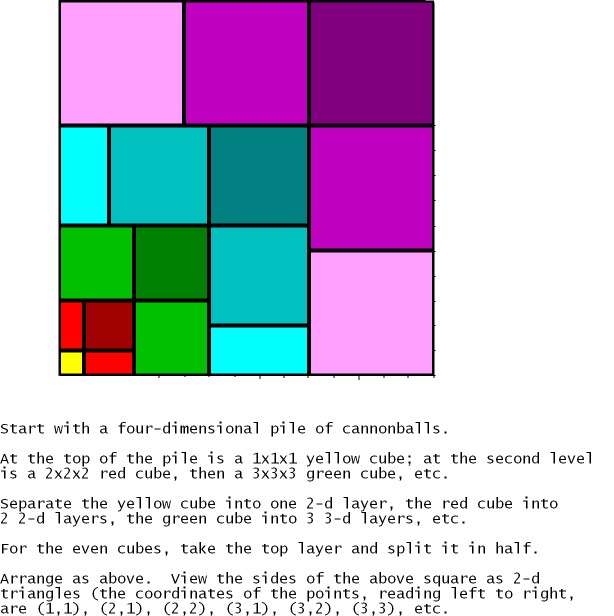Categorifying Nicomachus of Gerasa’s Equation
Posted by John Baez
I’ve been having a fun conversation with Gavin Wraith, who allowed me to post parts of it here.
It leads up to a puzzle about this famous formula:
I hope you know this one. Take the first natural numbers: the sum of their cubes is the square of their sum!
This formula is attributed to Nicomachus of Gerasa, a Pythagorean living in Syria from 60 to 120 AD, who is famous for his Manual of Harmonics and Introduction to Arithmetic.
As you’ll see if you click the link, the latter book was also deeply connected to Pythagorean music theory… a topic I had fun exploring in week266. It’s a digression from our main theme here, but I can’t resist mentioning that he thought a lot about this triangle I talked about:
1 2 4 8 16 ....
3 6 12 24 ....
9 18 36 ....
27 54 ....
81 ....
The first row consists of powers of two, each other number is the sum of the two above it… and the diagonal consists of powers of three! In fact, this triangle contains all the numbers of the form . It shows up when you study the musical intervals made from octave and perfect fifths.
Anyway, Gavin wrote:
While on the topic of maths and antiquity, here is a bit of gossip. You know the nice formula that says
discovered by Nicomachus of Gerasa? Gerasa (‘cherry orchard’ in Greek) is the modern Jerash in Jordan. A friend of mine, Othman Malhas in the Physics department of Yarmouk University, has converted an old building there as a conference centre in honor of Nicomachus, with marble floors inlaid with geometrical constructions. So next time you are in that part of the world (Jerash has the best preserved Roman forum to be found anywhere) give the Nicomachus Centre a visit.
This reminded me how much I loved this formula for the sum of cubes, and it prompted in me the wish for a ‘bijective proof’. A bijective proof of an equation between natural numbers is one that actually constructs a one-to-one mapping between two sets having those numbers of elements. Since passing from natural numbers to finite sets is one of the most basic examples of ‘categorification’, and Gavin Wraith is fond of that, it seemed like a natural question.
And I hoped that this in this case, the bijective proof could be nicely geometrical:
Yes, I know and love that formula. It would be nice to exhibit it as a way of taking the balls in a 4-dimensional stack of cannonballs with cubical layers, and rearranging them to form a 4-dimensional shape that’s a product of two triangles.
And Gavin obliged me by coming up with such a proof!
Can you? Of course there could be many, in which case we want the ‘nicest’ one, whatever that means.
After some of you succeed, or you all give up, I’ll tell you Gavin’s proof.



Re: Categorifiying Nichomacus of Gerasa’s Equation
A proof by pictures is given on page 58 of Conway and Guy’s The Book of Numbers. If I have a little more time today, I might write out what the pictures say.